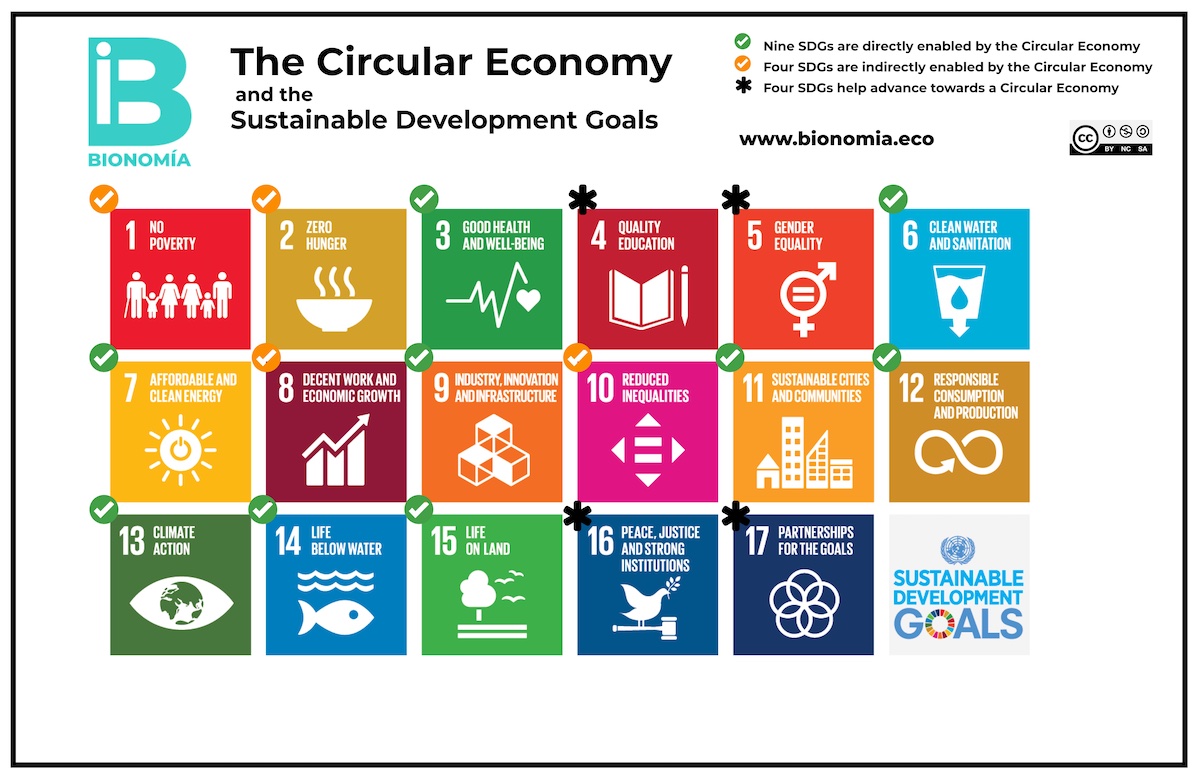At the request of a client, we have produced this graphic which succinctly explains the relationship between the Circular Economy and the United Nations Sustainable Development Goals.
=> There are nine SDGs directly enabled by the Circular Economy
=> There are four SDGs indirectly enabled by the Circular Economy
=> There are four SDGs that facilitate the implementation of the Circular Economy

Let’s look at the relationships one by one:
- No Poverty. The circular economy makes this possible indirectly by creating economies that are more labor-intensive, more local, and more resilient to crises.
- Zero Hunger. The circular economy makes this possible indirectly by fighting food waste and promoting the regeneration of fertile soils and sustainable agriculture, among other measures.
- Good health and Wellbeing. The circular economy makes this possible directly by eliminating pollution and toxicity, among other measures.
- Quality Education. This SDG facilitates the implementation of the circular economy through training in circular economy concepts and tools.
- Gender Equality. This SDG facilitates the implementation of the circular economy, as companies with improved gender diversity on boards are more likely to adopt CE frameworks.
- Clean Water and Sanitation. The circular economy makes this possible directly by promoting the circular use of water, and the elimination of pollution and toxicity.
- Affordable and Clean Energy. The circular economy makes this possible directly by requiring renewable energy sources in all its processes.
- Decent Work and Economic Growth. The circular economy makes this possible indirectly by capturing the value that the linear economy destroys, by increasing resilience and by increasing intensity in employment, among other measures.
- Build resilient infrastructure, promote inclusive and sustainable industrialization and foster innovation. The circular economy makes this possible directly by seeking durability, modularity and circularity of the built environment, and by promoting business model innovation, among other measures.
- Reduced inequalities. The circular economy makes this possible indirectly by fostering economies that are more local, more intensive in employment, and by reducing dependency on scarce resources, among other measures.
- Sustainable Cities and Communities. The circular economy makes this possible directly by making circular cities true hubs and engines of the transition to the circular economy.
- Responsible Consumption and Production. The circular economy makes it possible by eliminating waste, pollution, and toxicity while limiting obsolescence and promoting reuse, sharing, and more resposible models for delivering value.
- Climate Action. The circular economy makes this possible directly, since 45% of greenhouse gas emissions are due to the linear manufacture of goods and the production of food.
- Life below Water. The circular economy makes this possible directly by eliminating toxicity, pollution and waste that impact the marine environment, such as single-use plastics, among other measures.
- Life on Land. The circular economy makes this possible directly by eliminating toxicity, pollution and waste that impact the terrestrial environment, while promoting the regeneration of soils and natural assets.
- Peace, Justice and Strong Institutions. This SDG facilitates the implementation of the circular economy through legislative and institutional actions aligned with the objectives of the circular economy.
- Partnerships for the Goals. This SDG facilitates the implementation of the circular economy through collaboration, the fusion of knowledge and the dissemination of circular economy best practices.
